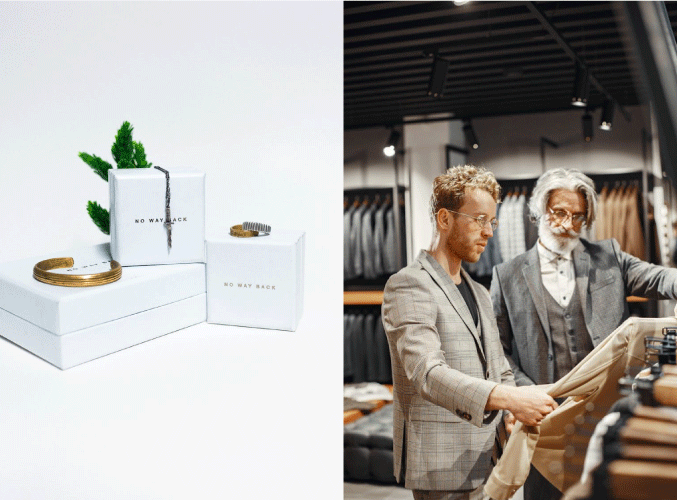In today’s competitive luxury market, brand storytelling has become a key tool for creating emotional connections with clients. Luxury brand storytelling is not just about delivering facts about a product; it’s about crafting a narrative that resonates with the client on a personal level, inspiring emotion, and ultimately, loyalty. This process is central to the luxury customer experience, where every interaction is an opportunity to tell a story, engage emotionally, and create lasting connections.
The Importance of Storytelling in Luxury Sales
As we all know, luxury products are more than just high-quality items; they are symbols of aspiration, success, and personal identity. In a world where countless brands are vying for consumer attention, storytelling offers an edge. The ability to convey the heart of a brand – its heritage, mission, and craftsmanship – can turn a simple purchase into an emotional journey for the customer. A brand’s story can create desire, instill loyalty, and transform a mere transaction into a memorable experience.
Take the example of Ermenegildo Zegna. A brand deeply rooted in tradition, Zegna’s narrative of producing fine clothing from merino wool sourced from their own farm in Australia is an integral part of their identity. When Zegna salespeople narrate this story, they’re not merely sharing product details; they’re inviting customers into the world of meticulous craftsmanship and ethical sourcing. This creates a sense of belonging and pride among their clientele, enhancing the emotional connection to the brand.
Similarly, Apple has mastered the art of brand storytelling. It’s not just about selling tech; it’s about selling the dream of a more convenient, pleasurable life. Their story revolves around innovation, simplicity, and enhancing the user experience – values that resonate with millions worldwide. As Simon Sinek famously said, “People don’t buy WHAT you do, they buy WHY you do it.”
In cities like Dubai and Abu Dhabi, where luxury shopping is not just an activity but a way of life, brand storytelling is essential. The UAE’s fast-growing luxury market, particularly in areas like the Dubai Mall and Abu Dhabi’s luxury districts, underscores the need for sales teams to become not only product experts but also skilled storytellers who can articulate the deeper meaning behind each brand.
The Challenge: Why Salespeople Shy Away from Brand Storytelling
Despite its importance, many luxury sales teams shy away from storytelling. Why? One common reason is that salespeople often feel restricted by the sales training they receive. For example, scripted lines or pre-set facts about a brand may feel forced and unnatural to them. Many believe that their primary role is to sell the product, rather than engage with the customer on an emotional level.
This is where effective learning and development comes into play. Brand storytelling can’t be taught through rote memorisation; it must be about engagement, passion, and understanding. Luxury salespeople need to feel the story, live the story, and then share it in a way that feels natural to each individual customer.

Training Sales Teams to Tell a Brand’s Story
To transform luxury salespeople into effective brand storytellers, brands need to rethink their sales training programs. Training shouldn’t just focus on memorising facts or pushing sales – it must be about connecting emotionally with the client. Below are a few methods to effectively train sales teams to engage clients emotionally through storytelling:
1. Loosen the Script
Many luxury brands equip their sales teams with a script or a set of facts about their products. While this is useful for standardising certain elements of the sales pitch, it can stifle creativity and emotion. Instead of rigidly sticking to the script, salespeople should be encouraged to narrate the brand story in a personal, spontaneous way.
The key to great storytelling lies in flexibility. Salespeople should be given the freedom to select which aspects of the brand’s history, craftsmanship, or values resonate most with the client in front of them. For instance, luxury brand training can focus on guiding the salesperson to understand the most engaging parts of the brand story, while leaving the specifics open for personal interpretation. This allows each interaction to be unique, and customers are more likely to connect with an authentic narrative rather than a rehearsed one.
2. Encourage Emotional Immersion in the Brand
For a salesperson to effectively share a brand’s story, they must first immerse themselves in it. This involves more than just reading brochures or watching promotional videos; it’s about feeling the brand’s ethos.
Team building activities, such as visits to the brand’s manufacturing facilities or workshops with artisans, can help sales teams connect emotionally to the brand. This experience gives them a deeper understanding of the values and craftsmanship behind the luxury products they are selling, making it easier for them to share the story with passion.
3. Teach Flexibility in the Sales Process
Every customer interaction is different, and not every client is ready to hear the brand story right away. While some customers may be receptive to a full narrative from the beginning, others may prefer a more low-key introduction. Salespeople should be trained to read the situation and adjust their approach accordingly.
For instance, instead of following a rigid step-by-step process, salespeople should be taught to respond to the customer’s cues. If a client seems intrigued by a product’s design, for example, the salesperson might talk about the craftsmanship behind it, drawing from the brand’s history. Alternatively, if a client is more interested in the emotional value of the product, the salesperson can focus on the lifestyle and aspirational aspects of the brand story.
4. Incorporate Emotion in the Selling Process
Luxury brands are built on emotions – the emotions they evoke in customers, and the emotions customers associate with their products. Salespeople must be trained to identify emotional triggers and use them to their advantage. A perfume and cosmetic training session could include lessons on how different scents or textures can evoke feelings of elegance, confidence, or warmth, and how to use those feelings to connect with the customer.
A good example of this is Burberry in Dubai. Burberry’s store staff are well-trained in guiding customers through the brand’s rich history and iconic pieces, such as the classic trench coat. This allows them to craft an emotional connection that transcends mere product features. Similarly, in Abu Dhabi, luxury brands often rely on their sales teams’ ability to craft personal stories around their high-end fragrances, turning a simple purchase into a lasting emotional memory.
5. Continuous Learning and Development
The luxury industry is ever-evolving, and so are the ways in which customers engage with brands. A strong learning and development programme is essential for keeping sales teams up-to-date with the latest trends in storytelling, customer engagement, and brand communication.
Luxury brands in the UAE, such as Chanel, Louis Vuitton, and Gucci, regularly host in-depth training sessions for their sales staff, ensuring they stay on top of new storytelling techniques and are prepared to adapt to the evolving needs of high-net-worth clients. These ongoing workshops also provide opportunities for staff to exchange insights and discuss what strategies are working best on the floor.
The Power of Emotional Connections
The future of luxury sales relies on creating deeper emotional connections with clients. Luxury is not just about selling a high-priced product; it’s about providing a luxury experience that speaks to the heart of the customer. Salespeople who are adept at storytelling can build relationships that go beyond the transaction, ultimately ensuring long-term loyalty and repeat business.
In addition to product knowledge, team building activities and sales training should focus on developing skills like empathy, listening, and emotional intelligence. By understanding the client’s desires, needs, and aspirations, salespeople can deliver personalised experiences that are both memorable and impactful.
Conclusion
The art of luxury brand storytelling is more than just a marketing tactic; it is a fundamental part of how a luxury brand engages its clientele. In the UAE’s competitive luxury market, especially in hotspots like Dubai and Abu Dhabi, training sales teams to tell a compelling, emotional brand story is crucial for success. By shifting from scripted lines to personalised, passionate storytelling, luxury brands can transform the customer experience, build deeper connections, and foster lasting loyalty. With the right learning and development initiatives, team building, and sales training, sales professionals can unlock the emotional key to their clients’ hearts, turning every sale into a unique, unforgettable experience.


